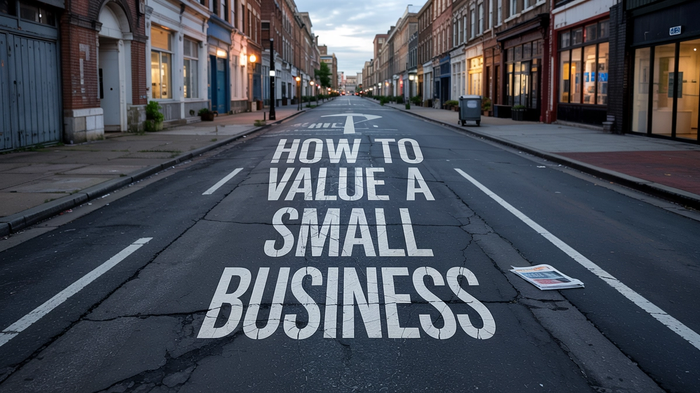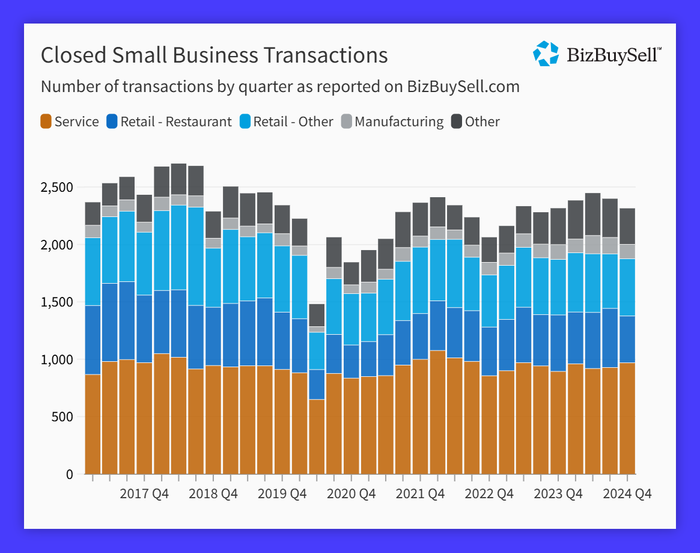For many small business owners, the idea of valuing their business feels distant – something only big corporations do. But knowing what your business is worth?
Maybe you're thinking of selling. Maybe you’re eyeing a loan or bringing in investors. Or maybe you just want to know if all your hard work is paying off.
The great news is that you don’t need an accounting degree to figure it out.
In this guide, we’ll break down the most common valuation methods, explain the key terms, and show you simple formulas you can run yourself – with examples that make the math less intimidating.
Why should small business owners care about valuation?
Most small business owners wait too long to ask, ‘What’s my business worth?’ They only start thinking about it when they’re ready to sell, seek funding, or negotiate with investors. By then, it’s often reactive – and limits your options.
But knowing your business’s value before you need it gives you leverage. It helps you:
- Negotiate from strength if someone offers to buy your company
- Secure better loan terms because lenders trust businesses that know their numbers
- Track your true growth, not just revenue or customer counts, but actual equity
- Spot weaknesses – like being too reliant on a single customer or lacking recurring revenue – that could drag down your value.
Precise business valuation shows you where you stand, so you can make smarter decisions while you’re still in the driver’s seat.
Prepare for valuation: lay the groundwork for accurate results

Before jumping into calculations, take time to set the foundation. A good valuation depends on accurate, well-prepared data. These steps help ensure your numbers reflect reality.
1. Get familiar with key financial terms
Valuation methods rely on certain metrics. Understanding these terms helps you use the formulas correctly:
- SDE (Seller’s Discretionary Earnings): Net profit plus the owner’s salary and personal expenses covered by the business. This is the standard for most small businesses
- EBITDA (Earnings Before Interest, Taxes, Depreciation, and Amortization): A measure of operating profit that removes non-cash and financing costs. Larger businesses prefer this for a cleaner view of operations
- Cash flow: The actual money left after expenses. It reflects how much cash the business generates
- Valuation multiple: A number (e.g., 2× or 3× SDE) used to scale earnings into a business value
- Discount rate: A percentage used in future-cash-flow methods to account for risk. The higher the risk, the higher the discount rate.
Choosing between SDE and EBITDA
- Use SDE if you’re an owner-operator. It captures the full financial benefit you take from the business, including your salary and perks. This gives a clearer picture of what the company puts in your pocket each year
- Use EBITDA if you have external management and clean financial separation. It strips out personal expenses and financing choices, showing pure operational performance. It’s more suitable when the business runs independently from the owner’s day-to-day involvement.
2. Gather your financials
Before you can value your business, you need to know what’s under the hood. These are the documents and figures that show how your company’s been performing and what it owns. Don’t worry, you don’t need an accountant’s eye – just a clear snapshot of where you stand.
Core financial statements (show profit trends)
- Profit & loss statements (last two–three years) – these give a clear view of your sales, expenses, and profits over time
- Balance sheets (assets, liabilities, equity) – this tells you what you own versus what you owe
- Tax returns (2+ years) – confirm the accuracy of your reported earnings and back up your numbers with what’s been submitted to tax authorities.
Assets & liabilities (show what backs your business)
- List of assets – things like equipment, vehicles, property, inventory. They’re what a buyer or investor might inherit, so it’s naturally important to them.
- List of liabilities – loans, credit lines, leases, and unpaid bills. They reduce your business’s net worth, so knowing them upfront helps avoid surprises.
Extras that boost value
- Intellectual property – patents, trademarks, proprietary tech, customer databases. These can add serious value, even if they don’t show up on your balance sheet
- Recurring revenue sources – long-term contracts, subscriptions, retainers. These show stability and future earning potential, which buyers or lenders love.
Having these details in order makes the rest of the valuation process faster and more accurate. It helps you avoid undervaluing (or overhyping) your business.
Need help getting the numbers straight?Check out:
- Small business bookkeeping for beginners
- 5 must-have small business balance sheet templates for efficient accounting.
3. Clean up financials (especially if you’re selling)
If you’re valuing your business for a sale – or even just preparing to pitch to investors – your financials must tell the real story of what the business earns. That means scrubbing out anything that could confuse or mislead.
Here’s what to do:
- Double-check for accuracy → Small errors in your books can throw off the entire valuation. Make sure income and expenses match your supporting documents
- Add back personal expenses → This includes things like your car lease, meals, or that phone bill run through the company. These aren’t business essentials, but they affect net profit, so adding them back shows true earnings potential for a new owner
- Exclude one-time costs or windfalls → If you had a big equipment purchase or an unusual contract that increased revenue, pull those out. Valuations work best on what’s repeatable.
Clean, honest financials increase your credibility and can bump up your valuation.
Buyers and investors need to trust your numbers. If they don’t, they’ll either walk away—or lowball.
Tip: If your books have been a bit unorganized, this is a good moment to work with a bookkeeper. Even one clean year of records can make a big difference in how your business is valued.
4. Consider professional help
You can run a rough valuation on your own – we’ll walk you through that. But if you’re gearing up for a major decision, like negotiating a sale, bringing on investors, or splitting equity with a partner, it pays to get a second opinion.
A professional appraiser or accountant can:
- Spot blind spots in your numbers (they know where things get messy)
- Help justify your asking price to buyers, investors, or lenders
- Bring credibility to the table—third-party validation goes a long way in negotiations.
It’s like selling your house – you can estimate its worth, but it’s often a real estate agent that knows the market and gets you the best price.
Valuation methods for small business
#1 - Income approach: what your future earnings say about your business value
The income approach is all about what your business could earn in the future.
If someone were buying your company, they wouldn’t just care about today. They’d want to know how much profit it can bring in tomorrow. This method helps put a price on that potential.
Two ways to approach future income:
Option 1: quick earnings multiple (capitalized earnings)
For steady income, this method is a solid place to start. Take your yearly earnings and multiply them by a number (called a multiple) based on your industry.
- Example:If your business earns $100,000 annually, and similar businesses typically sell for 2.5× earnings, your estimated value would be:$100,000 × 2.5 = $250,000
The multiple depends on growth potential and industry demand.
- Low-growth fields (like retail)? Multiples of 2–3×.
- High-growth sectors (like tech)? Multiples go higher.
Example:
Liam runs a digital agency, providing marketing services to tech startups. He calculates his SDE (Seller’s Discretionary Earnings) at $130,000 after adding back his salary and personal expenses like a leased vehicle. In his region, digital agencies typically sell for around 2.8× SDE.
- $130,000 × 2.8 = $364,000
Or, if a buyer prefers to use a capitalization rate of 18% (reflecting the moderate risk level):
- $130,000 ÷ 0.18 = $722,222
The choice between multiplier and cap rate depends on buyer preferences – both methods give insight into how much Liam’s agency might be worth.
Option 2: forecasting your future (discounted cash flow)
If your business is growing or you have solid future plans, discounted cash flow (DCF) digs deeper.
Here’s the simple idea:
- Estimate how much cash flow you’ll generate over the next 5–10 years.
- Adjust for risk and time (because $100 today is worth more than $100 next year).
- This tells you what all those future profits are worth right now.
Example:
Liam expects the agency to generate $150,000 in annual cash flow for the next 5 years. Using a discount rate of 15% (reflecting market risk for small agencies), the calculation looks like this:
- Year 1: $150,000 / (1.15)^1 = $130,435
- Year 2: $150,000 / (1.15)^2 = $113,425
- Year 3: $150,000 / (1.15)^3 = $98,635
- Year 4: $150,000 / (1.15)^4 = $85,768
- Year 5: $150,000 / (1.15)^5 = $74,583
If Liam projects a terminal value of $250,000 (based on a final sale or exit strategy):
- Terminal Value discounted: $250,000 / (1.15)^5 = $124,222
Adding it all up:
DCF valuation = ~$627,068
Which method works for you?
- Earnings multiple → Simple, quick, best for stable businesses.
- DCF → More detailed, great for growing businesses or those expecting big changes.
Tip: You can use benchmarks from platforms like BizBuySell Insight Reports, which track small company sales by industry.

Market approach (comparables)
The market approach helps estimate the value of your business based on real sales of similar companies. Instead of focusing on earnings or assets, it looks at what buyers have actually paid for comparable businesses.
In 2024, small businesses typically sold for about 0.67× annual revenue or 2.57× annual profit. But those numbers are just broad averages. Digital agencies or consulting firms may have different benchmarks than, say, a retail store or manufacturer.
That’s why industry-specific research is so important.
Market approach formula:
Value = Revenue × Industry Multiple or % Benchmark
- Revenue: Your total income from services or product sales over a year.
- Industry multiple: The percentage or factor (like 0.5× or 60%) typically used in your sector.
Example:
Liam checks recent sales of small digital agencies in his region. He finds that similar firms typically sell for 60% of annual revenue.
Last year, his digital agency brought in $400,000 in revenue:
- $400,000 × 0.60 = $240,000
That’s Liam’s market-based valuation – grounded in what similar agencies are fetching.
This method anchors your expectations in the real world. It reflects what buyers are actually paying today, not theoretical value based on future growth or assets alone.
But be cautious. The right benchmark depends on:
- Location (a London agency may sell higher than a rural one).
- Size and profitability (larger firms often sell at higher multiples).
- Client base stability (agencies with long-term contracts tend to attract higher offers).
So, always compare apples to apples – not a boutique agency to a global consultancy.
Asset-based approach
The asset-based approach values your business by adding up what you own and subtracting what you owe. It’s straightforward – and works best if your company holds valuable assets like equipment, property, or intellectual property.
For service-based firms like Liam’s agency, where physical assets are minimal, this method often acts as a baseline valuation: useful, but not the full story.
Asset-based formula:
Value = Total Business Assets – Liabilities
- Assets: Everything your company owns. This could include tangible assets (equipment, office furniture, computers) and intangible assets (brand reputation, client relationships, proprietary processes, intellectual properts like designs or code)
- Liabilities: Any outstanding debts or obligations: loans, credit lines, or unpaid bills.
Example:
Liam lists what his digital agency owns and owes:
- $30,000 in laptops, software licenses, and office equipment
- $15,000 in intellectual property (like custom frameworks or client databases)
- $10,000 in business debt
Calculation:$30,000 + $15,000 – $10,000 = $35,000 asset-based value
A few things to know:
- Book value → Uses the numbers straight from your balance sheet (what your accountant reports).
- Adjusted asset value → Updates those numbers to reflect current market value. For example, that laptop you bought three years ago? It’s likely worth less today.
For agencies like Liam’s, intangible assets – like long-term client relationships or proprietary workflows – carry weight, even if they don’t show up neatly on a balance sheet. Some buyers will even pay more for these intangibles if you can prove their value (think: client retention rates or proprietary tools that give you an edge).
Liquidation value
Liquidation value is what you'd get if you had to sell your business assets fast — think closing the doors and clearing out everything. It’s often lower than asset value because you’re selling under pressure, not at market rates.
For service-based businesses like Liam’s agency, this number is usually modest. Physical assets – laptops, software licenses, office furniture – don’t hold high resale value, especially in a hurry.
If Liam ever had to liquidate his digital agency, he might recover only 60–70% of the estimated asset value. So if his adjusted asset value was $35,000, his liquidation value might fall between $21,000 and $24,500.
Which valuation method should Liam use?
For Liam, there’s no single right answer. Each valuation method tells a different story about his agency’s worth:
- The income approach highlights future earnings potential.
- The market approach shows what similar agencies sell for.
- The asset-based approach focuses on tangible assets (which might not be his agency’s biggest strength).
So, what should Liam do?
Pick two or three methods. Combining them gives Liam a rounded view of his agency’s value. For example:
- Use the market approach to see what other agencies like his are selling for.
- Combine it with capitalized earnings to reflect his steady income from client retainers.
- Add the asset-based approach as a baseline, even if his agency doesn’t own much physical equipment.
What if Liam gets different numbers?
Let’s say one method values Brightside at $180,000 and another at $400,000.
That’s normal.
Instead of worrying, Liam should:
- Average the numbers (or weigh them based on which feels more relevant).
- Double-check his math. Did he overestimate future cash flow? Did he use a realistic multiplier for his industry? Are there enough comparable agency sales in his region?
This gives Liam confidence in the numbers he’ll share with investors, buyers, or lenders.
Who’s buying Liam’s agency – and why does it matter?
Liam’s next step? Think about the buyer.
- If it’s a financial buyer (like an investor), they’ll care most about profit, risk, and cash flow.
- If it’s a strategic buyer (like a larger agency looking to expand), they might pay more for client relationships, team expertise, or market position.
Knowing who’s across the table helps Liam lean into the right valuation story – whether that’s highlighting predictable revenue or showcasing his agency’s stellar client list.
How Liam (and you) can increase business value
Valuing his agency helps Liam show up ready in talks with lenders, investors, or anyone interested in his business. And while the formulas help, there’s one more thing he can do: raise that value over time.
Even if you’re not planning to sell right now, growing your business’s value makes it easier to:
- secure funding,
- attract the right investors,
- or simply sleep better knowing your hard work is building something solid.
Here’s where Liam’s focusing his efforts – and where you can too:
- Lock in predictable income. Liam’s shifting more clients to retainer agreements. Buyers and lenders love that kind of stability because it makes future income easier to forecast.
- Cut external costs. He’s reviewing his software subscriptions and resigning from tools that don’t pull their weight. Cleaner margins mean stronger income-based valuations.
- Strengthen the brand. Liam’s doubling down on thought leadership – publishing niche insights, growing his LinkedIn presence, and ensuring his agency stays recognizable in a crowded market.
- Keep the books tidy. His accountant now reviews financials quarterly, not just at year-end. Up-to-date records show investors that everything’s in order.
- Diversify clients. Liam noticed 60% of his revenue came from two major clients. He’s now actively pitching new sectors to spread that risk.
- Document what works. Liam’s turning his best practices on onboarding new hired or managing projects into playbooks. That way, his agency can run smoothly even when he steps back.
It might feel like a lot – but start small. Even one tweak can make a noticeable dent in your business’s value.
After all, the goal isn’t to look valuable. It’s to be valuable.
Small business valuation is not so scary!
Getting to know your business value takes effort – but knowing it feels like clarity.
Running a small business means making decisions all the time. Some easy, some tough. Knowing what your business is worth makes those decisions easier.
You’ve put in the work. Now you’ve got the numbers to back it up. Good luck!
Frequently Asked Questions
One of the most common is:
Value = Seller’s Discretionary Earnings (SDE) × Industry Multiple.
Depending on your setup, you might also lean on methods like Discounted Cash Flow or Asset-Based valuations.
Start simple: take your annual SDE and multiply it by an industry average (usually between 2× and 4× for most small businesses). It won’t be exact, but it gives you a working estimate. To sharpen it, check recent sales of similar businesses in your industry.
EBITDA multiples usually land between 3× and 6×, depending on your industry, size, and growth potential. Tech firms or high-growth companies may sit above 6×. Smaller service-based businesses might use SDE instead of EBITDA – it’s often more accurate for owner-led operations.
They’re helpful for a ballpark figure. Add your profit, assets, and industry, and they’ll spit out an estimate. Just remember: they work off standard assumptions. It’s smart to pair the results with your own calculations or check with a pro.
Revenue multiples are another quick way to estimate. Industries set their own benchmarks – salons, for instance, might sell for 0.4× annual revenue, while a SaaS company could pull 3×. Always check what’s happening in your specific niche before running the numbers.




